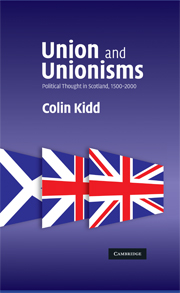Book contents
- Frontmatter
- Contents
- Preface
- 1 Introduction: the problems of Unionism and banal unionism
- 2 Unionisms before Union, 1500–1707
- 3 Analytic unionism and the issue of sovereignty
- 4 Narratives of belonging: the history and ethnology of organic union
- 5 From assimilationist jurisprudence to legal nationalism
- 6 The two kingdoms and the ecclesiology of Union
- 7 Early nationalism as a form of unionism
- 8 Conclusion
- Index
- References
3 - Analytic unionism and the issue of sovereignty
Published online by Cambridge University Press: 06 July 2010
- Frontmatter
- Contents
- Preface
- 1 Introduction: the problems of Unionism and banal unionism
- 2 Unionisms before Union, 1500–1707
- 3 Analytic unionism and the issue of sovereignty
- 4 Narratives of belonging: the history and ethnology of organic union
- 5 From assimilationist jurisprudence to legal nationalism
- 6 The two kingdoms and the ecclesiology of Union
- 7 Early nationalism as a form of unionism
- 8 Conclusion
- Index
- References
Summary
The Union of 1707 is an enigma which defies easy constitutional analysis. This undertaking took its rise from the reluctance of the Scots parliament to fall into line with the English Act of Settlement (1701) which entailed the English crown on the Hanoverian line. The Scots rejected overtures to agree the Hanoverian succession to the crown of Scotland. An alternative strategy to bring the Scots to accept the Hanoverian succession was to offer the Scots a Union with England which involved significant trading advantages for the Scots but also incorporated their recalcitrant parliament with England's and provided for their adherence to the Hanoverian succession. In the summer of 1706 two sets of commissioners acting on behalf of Queen Anne in her two distinct regal personalities as Queen Anne of England and Queen Anne of Scotland negotiated the terms of a Union agreement. These twenty-five Articles of Union – which dealt with the Hanoverian succession, the union of the two parliaments, fiscal matters, trade and the continuation of a separate system of Scots law, but wisely avoided the contentious issue of religion – were sent to the Scottish parliament for ratification. With some modest amendments and the addition of an Act – integral to the Union settlement – which guaranteed the privileges and autonomy of the established presbyterian Church of Scotland in perpetuity, the Articles of Union were embodied in an Act of the Scottish parliament.
- Type
- Chapter
- Information
- Union and UnionismsPolitical Thought in Scotland, 1500–2000, pp. 81 - 133Publisher: Cambridge University PressPrint publication year: 2008



